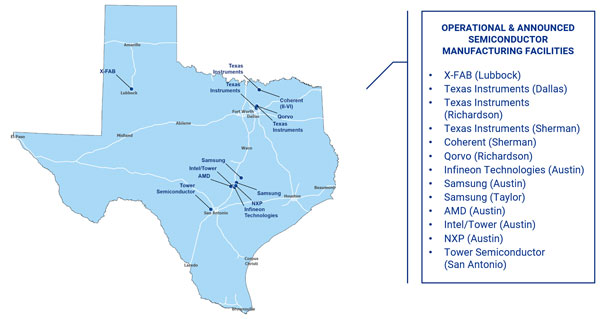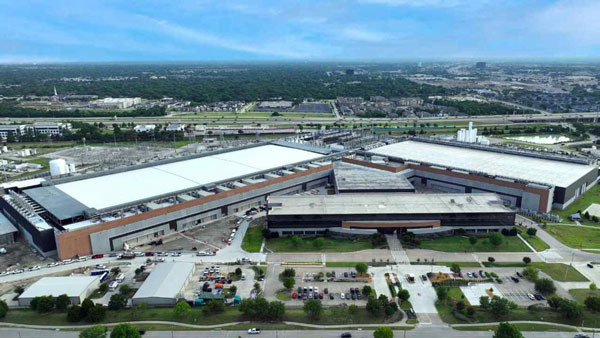The birthplace of the integrated circuit is spawning an integrated talent development system for the new chip manufacturing revolution.
No doubt Jack Kilby would have approved. The late Nobel Prize-winning electrical engineer for Texas Instruments in 1958 invented the integrated circuit along with Robert Noyce of Fairchild Semiconductor. Today, Texas Instruments is leading the charge of new facility investments in the state — 13 in all as of January 2024., with more supply chain investments along the way. The company anticipates spending as much as $30 billion on a potential four new fabrication plants in Sherman, where ground was broken in May 2022 not long before a new fab started production in Richardson in September 2022. Sherman also is welcoming a multibillion wafer manufacturing complex from Taiwan-based GlobalWafers. Samsung is investing $17 billion in a new facility in Taylor and plans as many as 11 new manufacturing facilities in Taylor and its Texas home base in Austin, increasing its total investment in the state to now over $40 billion.
In the last five years, there has been a 44% increase in firms across the state, says the Texas Economic Development & Tourism Office (EDT) within the Office of the Governor. The state has led the U.S. in semiconductor exports for the last 13 years in a row and in 2023 exported $20.5 billion worth of semiconductors and other electronic components — more than the combined value of what California, Arizona, New York and Florida exported.
Of the nearly 260 electronics industry projects tracked in Texas by Site Selection magazine since January 2019, 58 of them are in semiconductor and related device manufacturing. Even removing the 14 projects for which precise investment amounts are not available, the 44 remaining projects — including a $160 million project in the DFW community of Rockwall from Canada’s Ballard Power Systems — involve no less than $91 billion in capital investment.

Avenues to Opportunity
Today more than 43,000 Texans work in the semiconductor industry. New programs are paving the way for more, as the U.S. economy is expected to add around 115,000 more semiconductor jobs by 2030.
In late March 2024, The University of Texas at Austin, Austin Community College District (ACC) and Texas Institute for Electronics (TIE) announced they will make Central Texas a premier hub for “comprehensive workforce development that will fuel the needs of America’s semiconductor industry.” Among its components will be a joint Semiconductor Training Center (STC) and semiconductor curriculum and credentialing development that will “build stackable skill-based microcredentials and related education activities, with plans to develop K-12 partnerships.”
TIE will commit initial funding of $3.75 million to develop the STC and “will provide research opportunities for students and educators at its state-of-the-art chip fabrication facilities at UT’s J.J. Pickle Research Campus and its semiconductor plant on Montopolis Drive, originally home to Sematech. TIE has 84,000 sq. ft. of clean-room space. It also has $552 million appropriated to it by the Texas Legislature. The agreement will also leverage facilities of industry partners.
“We and our academic and industry partners understand this is a pivotal moment for America’s semiconductor industry and that we have a unique concentration of some of the world’s top talent, facilities, experience and funding to establish a sustainable workforce and establish long-term leadership,” said John Schreck, CEO of TIE, a partnership among the state, semiconductor and defense electronics companies, national labs, and 16 Texas-based academic institutions.
Around 31,000 of the nation’s 115,000 forthcoming semiconductor jobs (27%) are master’s degree level. So it’s only natural that UT has announced a new Master of Science in Engineering program with a major in semiconductor science and engineering to be launched in fall 2025. Meanwhile, ACC in fall 2023 developed the Semiconductor Technician Advanced Rapid Start (STARS) condensed, four-week upskilling curriculum in collaboration with the Austin Regional Manufacturing Association and regional employers such as Samsung Austin Semiconductor, NXP, Tokyo Electron, Infineon and Applied Materials. The first training programs expected to launch through the STC could begin as early as January 2025. Then there’s the area of future-skilling.
UT’s TIE and quantum computing company Infleqtion — which just opened its flagship corporate office in Austin last year — in October 2023 launched a vector to tomorrow with the signing of a memorandum of understanding to develop a new center of excellence for quantum manufacturing. “Quantum technologies will be increasingly important to both improving our lives and solving many of the societal challenges we face,” said UT President Jay Hartzell. “Infleqtion’s work in quantum physics complements the world-class expertise in many of our University’s disciplines, including semiconductors, AI, robotics and medicine. These areas are also at the forefront of discovery and commercialization, and our work with Infleqtion will help advance our goals while also providing a great example of the ways we are working more closely with partners in key industries.”
Texas in 2022 led the nation with approximately 36% of the total U.S. theoretical wafer manufacturing capacity.
The center, called qNexus, will scale the production of quantum-enabled devices to meet the growing demand of government and commercial markets. “Together, TIE and Infleqtion will prioritize growing tomorrow’s workforce and training and equipping professionals to meet the demands of quantum and photonic manufacturing,” the announcement stated, noting initial projects including “a high-precision atomic clock, an ultra-wideband quantum RF receiver, and core quantum components produced at scale nowhere else in the world, with potential for additional products such as inertial sensors, magnetometers and bioimaging devices.”
North Texas Hub
The emerging resources don’t stop there. One of the 31 inaugural Tech Hubs announced by the U.S. Department of Commerce’s Economic Development Administration in October 2023 is the Texoma Semiconductor Tech Hub across 29 counties in north-central Texas and southern Oklahoma, led by Southern Methodist University. Its mission? “By deploying a geographically-distributed ‘fablet’ model — building targeted, accessible labs for electronic design, semiconductor manufacturing, packaging, and testing — the Texoma Semiconductor Tech Hub will foster a consolidated semiconductor innovation ecosystem with supply chain resilience.”
 Texas Instruments’ RFAB opened in 2009 as the world’s first 300-mm. analog wafer fab. A second 300-mm. wafer fab connected to the first fab, RFAB2, started production in 2022 and in August 2023 achieved LEED-Gold version 4 certification, making it the first wafer fab in the United States and the fourth in the world to achieve this more stringent certification.
Texas Instruments’ RFAB opened in 2009 as the world’s first 300-mm. analog wafer fab. A second 300-mm. wafer fab connected to the first fab, RFAB2, started production in 2022 and in August 2023 achieved LEED-Gold version 4 certification, making it the first wafer fab in the United States and the fourth in the world to achieve this more stringent certification.
Photo courtesy of TI
The Tech Hub designation is “an endorsement of the region’s strategy to supercharge their respective technological industry to create jobs and strengthen U.S. economic and national security,” the EDA stated. “Designated Tech Hubs are now eligible to apply for the next phase of the Tech Hubs Program that will invest between $50-$75 million in each of five to 10 Designated Hubs. In addition to a Tech Hubs Designation, EDA announced that the Texoma Semiconductor Tech Hub (organized by the Texoma Semiconductor Innovation Consortium or TSIC) was also awarded a Tech Hubs Strategy Development Grant that will help the consortium increase local coordination and planning activities to strengthen its region’s capacity to manufacture, commercialize, and deploy critical technologies.”
Altogether, the TSIC consists of 12 major companies in the industry, six workforce development agencies, seven economic development organizations, 13 higher education institutions (including five research universities) and three local and regional governments, including the Choctaw Nation.
Lightcast estimates that more than 7% of U.S. semiconductor sales originate in Texoma. Growth coming from Texas Instruments and others in places like Sherman and Richardson only figures to grow that percentage as well as grow premium-salary jobs: Semiconductor jobs in the region pay an average weekly salary of $2,451, more than 40% above the average wage for all industries. Amid a total population exceeding 8.5 million, the TSIC says its regional workforce totals more than 4.7 million, with nearly 300,000 employed in high-tech fields and 55,000 annual completions from regional higher education institutions.
A wide range of workforce development programs across a variety of stakeholder institutions will help Texoma construct, the TSIC says, “a ladder to success” for the STEM semiconductor workforce.
The State With Its Own CHIPS Act
The Texoma-affiliated TSIC uses the same acronym as the Texas Semiconductor Innovation Consortium, one of the entities created when Texas Governor Greg Abbott signed into law the Texas CHIPS Act in June 2023, legislation resulting in part from the foresight of the governor’s creation of the National Semiconductor Centers Texas Task Force in October 2021.
“We are making investments to bring more than 90% of our wafer manufacturing and assembly and test operations internal by 2030. By owning and operating our manufacturing facilities, we are able to better control our supply chain and offer a greater assurance of supply for our customers around the world.”
— Texas Instruments, March 20, 2024
The new law also created the Texas Semiconductor Innovation Fund (TSIF) to leverage Texas’ investments in the semiconductor industry, encourage semiconductor-related companies to expand in the state, further develop the expertise and capacity of Texas institutions of higher education, and maintain the state’s position as the nation’s leader in semiconductor manufacturing. The TSIC and TSIF will be administered by the Texas CHIPS Office, a newly formed division within Governor Greg Abbott’s Economic Development & Tourism Office.
Texas lawmakers appropriated $698 million for the new semiconductor fund and an additional $666.4 million for the creation of advanced R&D centers at The University of Texas at Austin and Texas A&M University.
“Significant industry investments announced in Texas in the last two years will further accelerate domestic semiconductor manufacturing, reducing reliance on foreign production and supply chains and further ensuring our nation’s security,” Governor Abbott said upon signing the law. “Texas has the innovation, the infrastructure and the talent to continue to lead the American resurgence in critical semiconductor manufacturing and the technologies of tomorrow.”
